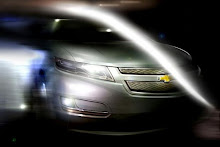
I've been watching these TV ads with T. Boone Pickens extolling the virtues of running cars on natural gas with some bemusement. I absolutely share his enthusiasm for energy independence, and I see his point about natural gas. We have lots of it here (it's our second largest natural resource), it's safe, it's cheap (the current national average price is just 58% that of gasoline on an energy-equivalent basis), it burns clean producing less critical greenhouse gasses than gasoline or diesel, and ordinary engines can be comparatively easily fitted to run on natural gas.
The Pickens Plan (pickensplan.com) envisions constructing a network of wind farms located right up the middle of the country (his site describes the Midwest as "the Saudi Arabia of wind") to replace the 22% of our electric power currently supplied by natural gas, so that the gas can be diverted to transportation uses. By his accounting, this could trim our foreign oil demand by 38%within 10 years, given sufficient political will and an investment of $1.2 billion in wind turbines and power-transmission infrastructure (paid for in part by a reduction in the $700 billion annual bill for foreign oil).

But today, of the reported 7-plus million natural-gas vehicles on the road, only about 120,000 of them are in the U.S., according to Natural Gas Vehicles for America. That's largely because of the 1100 or so of the nation's natural gas fueling stations, only about half are open to the public, and very few of these are co-located in one of the nation's 117,000 gas/diesel stations. That's why most of the natural-gas-powered vehicles here are taxis, street sweepers, Zambonis, city buses, garbage trucks, school buses, delivery vehicles, airport shuttles, and forklifts -- all limited-range vehicles running local routes near a central office and refueling station.
 I recently sampled a Honda Civic GX, which is the only natural-gas vehicle a normal civilian can buy -- and it's sold only in New York and California. It's rated by the EPA as the world's cleanest internal-combustion vehicle. At $25,760, it costs $1540 more than a Civic Hybrid and runs just about exactly like a "normal" LX or EX Civic sedan. Except that the pressurized cylinders containing the natural gas eliminate the fold-down seat option and reduce the trunk volume to a tight 6.0 cu ft.
I recently sampled a Honda Civic GX, which is the only natural-gas vehicle a normal civilian can buy -- and it's sold only in New York and California. It's rated by the EPA as the world's cleanest internal-combustion vehicle. At $25,760, it costs $1540 more than a Civic Hybrid and runs just about exactly like a "normal" LX or EX Civic sedan. Except that the pressurized cylinders containing the natural gas eliminate the fold-down seat option and reduce the trunk volume to a tight 6.0 cu ft.The 3600psi tank holds the equivalent of 8.0 gal of gas, which theoretically provides a range of between 192 and 288 miles, presuming you could use every bit of the natural gas and achieve the EPA city/highway numbers. But let's forget the highway number, because the refueling stations are too far apart to contemplate long-highway drives. The max useful range observed by myself (and Consumer Reports) was more like 150-180 miles of city driving. Kind of like an electric car.
The solution to the availability issue is an in-home refueling station that connects your car to the gas supply heating your home and water. These cost about $3500 (minus applicable tax incentives), meaning they're only likely to be installed by upper-middle-class home owners -- the same class of folk who are eagerly awaiting plug-in Chevy Volts and Priuses until Tesla builds a lower-priced EV sedan. Too few of these folks exist to alter the energy-use landscape in a meaningful way.
Seems to me the fastest route to energy independence is to tap our enormous coal reserves to produce gasoline and diesel via the Fisher-Tropsch process, augmented by as much cellulosic ethanol (and maybe methanol too) as we can distill. Natural gas will certainly have a roll to play, but I see it remaining in the commercial fleet realm for the foreseeable future.
